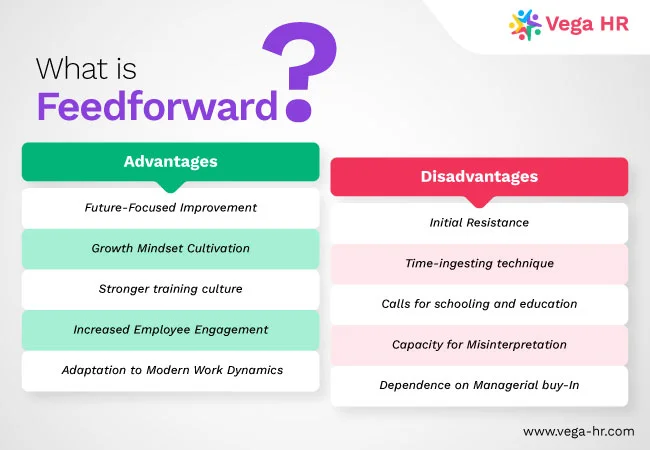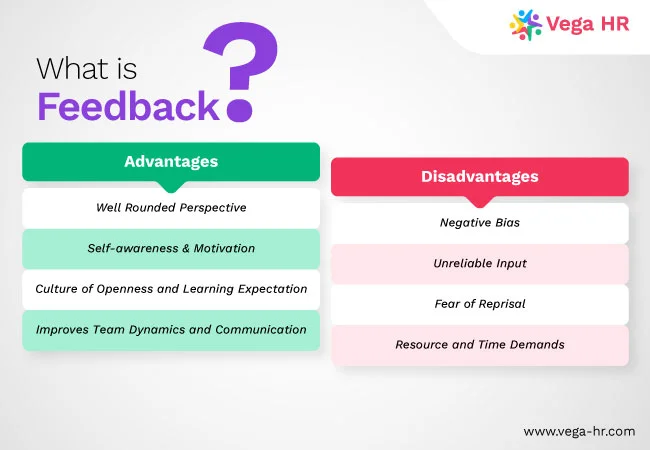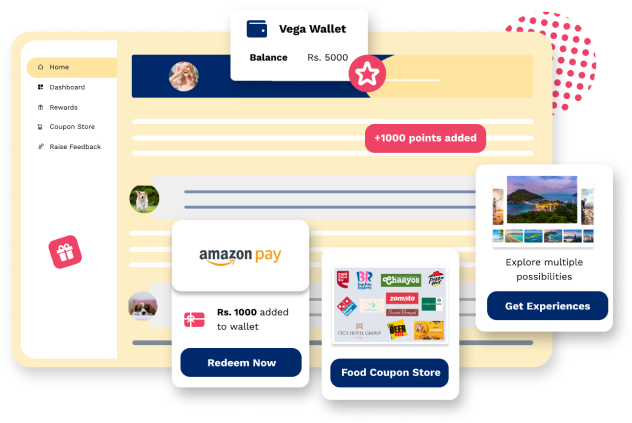Businesses are striving to stay ahead in the continuously changing and demanding business environment of today. This has led to a desire among firms to develop new strategies. Across the globe, more attention has been paid to feedback and feedforward as alternative methods of performance improvement.
Difference between feedback and feedforward, Feedback is one such process that involves sharing experiences and results in a bid to learn from mistakes and refine processes, but if not thoughtfully implemented, it can generate a culture of blame and stagnation. Feedforward, on the other hand, suggests ways of improving performance for future reference by encouraging proactive problem-solving and innovation.
This article will attempt to expose the main differences between feedback and feedforward; which strategy works best for organizational development and how can they be effectively integrated to optimize results?
We came across these two terms feedback and feedforward, even if it's completely new, absolutely it's not an issue. Let's dive into these concepts to get a better understanding of how they can contribute to bringing a positive turnaround in the organizational culture.
What is Feedforward?

The concept of feedforward was created in 1976 by Peter W. Dowrick in his doctoral thesis . Feedforward, according to cognitive-behavioral theories, is a method of teaching and learning that illustrates or indicates a future behavior or path desired for a goal. It acknowledges your current strengths and the areas where you have room for development, and it focuses on enhancing your abilities in those areas.
Examples of Feedforward
1. Sales Presentation Example: James, a new sales representative, is preparing for her first presentation. His manager, Katie, suggests a mock presentation to help James anticipate potential issues and develop strategies to overcome them. This is an example of feedforward, as Katie is focusing on the future and helping James prepare for future success.
2. Marketing Presentation Example: Sasha has just finished presenting a marketing plan. Her supervisor offers suggestions on how to improve future presentations, such as including more data and reducing content on slides. This is an example of feedforward, as the supervisor is focusing on the future and providing actionable advice for improvement.
Everything has its advantages as well as its disadvantages. Therefore, going through a discussion regarding the advantages and disadvantages of feedforward will be essential before considering it as a culture for implementation.
Advantages:
Future-Focused Improvement: The encouragement of continuous learning and progress is achieved through actively taking steps to modify and improve processes with the goal of optimizing results.
Growth Mindset Cultivation: Feedforward encourages an increased attitude by means of identifying possibilities for development, supporting personnel who believe that abilities and intelligence can be evolved through efforts.
Stronger training culture: Through peer-to-peer coaching and collaboration, interpersonal relationships within organizations flourish, leading to increased organizational harmony.
Increased Employee Engagement: With clear guidance and support, employees are able to map out their own path, promoting their growth and achievements.
Adaptation to Modern Work Dynamics: Rapid change and uncertainty can be effectively managed through agility and versatility, which allow for the adaptation to emerging trends.
Are You Ready to Supercharge Your Employee Engagement Initiatives?
Explore Vega HRs Comprehensive Suite of Employee Engagement Solutions Designed to Transform Your Workplace to Ensure Success.
Disadvantages:
Initial Resistance: Imposing feedforward might also require substantial cultural shifts and may start to face resistance from employees who are accustomed to traditional remarks techniques.
Time-ingesting technique: While feedforward can be more efficient than traditional feedback, it still requires a structured process and may initially be more time-consuming to implement
Calls for schooling and education: Employees need to be educated on the significance and benefits of feedforward, which can be a time-consuming and resource-intensive manner.
Capacity for Misinterpretation: Feedforward must be carefully carried out to keep away from misinterpretation or misuse, as it is able to be easily misunderstood if not properly framed.
Dependence on Managerial Buy-In: A proactive problem-solving approach's success is heavily dependent on the support and involvement of managers, but this can be difficult to achieve if managers are not completely dedicated to the method.
Overall, feedforward offers significant benefits in terms of fostering a growth-oriented corporate culture, but its implementation requires careful planning, training, and managerial support to overcome potential challenges.
What is Feedback?

Feedback is the information or comments given to someone about their previous actions or performance, with the intention of assisting them in enhancing their future endeavors. It emphasizes the examination of previous actions and offers both constructive criticism and praise. Nevertheless, feedback can occasionally be perceived as negative or confrontational, as it draws attention to errors or shortcomings.
Advantages of Feedback
Well-Rounded Perspective: From managers, peers, subordinates, and even external clients this method gives an overall view of the work and performance which can be improved in a simple form of feedback.
Self-awareness & Motivation: Feedback is the mirror showing you how you have been seen and thought of by people in the organization. In the best of cases, this provokes self-awareness, one of the most potent drivers of growth and positive change.
Culture of Openness and Learning Expectation: A culture where people feel comfortable providing feedback drives open communication, breaks down silos and perpetuates a cycle of learning and growth.
Improves Team Dynamics and Communication: Multi-source feedback enhances transparency, clarifies expectations, and promotes mutual understanding and respect among employees
Disadvantages of Feedback
Negative Bias: Feedback can inadvertently become a platform for negativity, focusing on flaws and grievances rather than constructive improvement. This often reflects a larger issue within the organizational culture itself.
Unreliable Input: Feedback from colleagues who lack direct experience with an individual's work can be superficial or overly positive, lacking in concrete details. This can distort the overall performance picture and hinder accurate assessment.
Fear of Reprisal: Employees may hesitate to provide honest and critical feedback if they believe managers have access to their input. This fear of retaliation can stifle open communication and hinder constructive criticism.
Resource and Time Demands: Establishing a robust feedback system requires substantial resources and significant time commitment. Organizations must be prepared to invest in the necessary infrastructure to ensure effective implementation and utilization of feedback initiatives.
Strategies to implement feedback for having an effective and positive impact in your organization
To maximize the positive impact of feedback and minimize potential challenges, organizations should adopt the following strategies:
- Provide comprehensive guidance on effective feedback practices to ensure constructive and respectful communication.
- Protect employees' privacy by ensuring their feedback is handled with utmost discretion.
- Regularly gather employee feedback and adapt the system to meet evolving organizational needs.
Cultivating a growth mindset involves encouraging an increased attitude by identifying opportunities for development and supporting individuals who believe that abilities and intelligence can be evolved through efforts, therefore look no other than Vega Pulse Survey
By effectively managing feedback, organizations can promote a thriving environment that encourages innovation, engagement, and ultimately, success.
A recent Gallup and WorkHuman study found that reward & recognition leads to higher productivity which is a result of giving regular feedback to the employees. In the long run, this has a ripple effect in the organization, with high levels of job satisfaction and improved employee retention.
Now, let's understand how both feedback and feedforward can be different in their own ways when inculcated in an organization.
Feedback vs. Feedforward: Choosing the Right Approach
The effectiveness of feedback and feedforward depends largely on the context and specific goals of the organization. Here's a breakdown of when each strategy excels:
When to Use Feedback?
Performance Reviews: Formal performance assessments heavily depend on feedback, which offers a comprehensive evaluation of past performance. This feedback, often gathered through employee feedback forms, helps identify both strengths and areas requiring improvement.
Skill Enhancement: By receiving targeted feedback, specialists can improve their skills by focusing on and addressing specific technical weaknesses, leading to enhanced performance.
Accountability: Employee growth and development can be significantly enhanced through the provision of constructive feedback. This feedback allows employees to recognize the areas in which they need to improve and offers guidance for achieving those improvements, thereby ultimately enhancing their professional skills and performance. In essence, constructive feedback is crucial for the progress of employees.
When to Use Feedforward?
Innovation and Creativity: Through emphasizing positive reinforcement and constructive feedback, feedforward helps create a culture that promotes growth, improvement, and experimentation. This culture encourages collaboration, risk-taking, and openness to new methods, ultimately leading to increased innovation and creativity.
Personal Development: Including feedforward in your organization's culture can help establish an environment that encourages constant personal and professional development. As a result, this can enhance employee engagement, boost performance, and give your company a competitive advantage in the market.
Change Management: Through the implementation of feedforward control, employees are motivated to proactively anticipate and address changes prior to their escalation into significant problems. This strategy effectively fosters the development of necessary skills and adaptive mindset among employees, enabling them to manage and thrive in shifting circumstances.
Consistent communication is key to building positive relations. Ensure your employees stay in touch with each other and create an amazing workplace culture
Vega Social helps in creating an engaging environment within the organization by providing various features to connect with employees like the Chat feature, sending gifts and recognitions, and sharing them across various social media apps using the app integrations. This altogether helps in staying connected with your peers even from a remote setting contributing to a positive work culture.
Bringing out the differences between two concepts is important in understanding them vividly and which of them can be the best practices to apply to an organization. But, how about we discuss creating a combination of two essential elements important in building a healthy and engaging organizational environment, i.e. Feedback and Feedforward.
The Power of Combining Feedback and Feedforward
Although often presented as separate strategies, feedback, and feedforward are most effective when combined. This synergistic approach allows organizations to cultivate a holistic and sustainable culture of improvement.
Feedback provides invaluable insights into past performance, highlighting areas for growth and development. Feedforward, conversely, empowers individuals to translate these insights into concrete steps for future success. By integrating feedback and feedforward, organizations can create a continuous cycle of improvement. This ongoing process encourages individuals to continuously learn, adapt, and grow, promoting a dynamic and productive environment.
Conclusion
The key to true organizational transformation lies not in choosing between feedback and feedforward, but in their powerful combination. By merging the insights of feedback with the forward-looking perspective of feedforward, organizations can cultivate a dynamic and sustainable culture of continuous improvement. This integrated approach promotes a growth-oriented environment, empowering employees to learn, adapt, and thrive, ultimately driving innovation, engagement, and exceptional success.
Are you ready to empower your organization with employee engagement initiatives?
About Vega HR
Vega-HR is a powerful tool in the talent war, offering employee rewards, recognition, and pulse recognition. With an engaging platform, it fosters a world-class work culture, providing P2P recognition, social feedback, on-spot recognition, and monetizable incentive solutions with 3000+ coupons in various categories.
Create a Culture People Want to Stick to
- Send rewards
- Give shoutouts
- Build a community
- Gift experiences
Get a demo
 Written by Hrithik Das 14 June 2024 | 4 min read
Written by Hrithik Das 14 June 2024 | 4 min read






